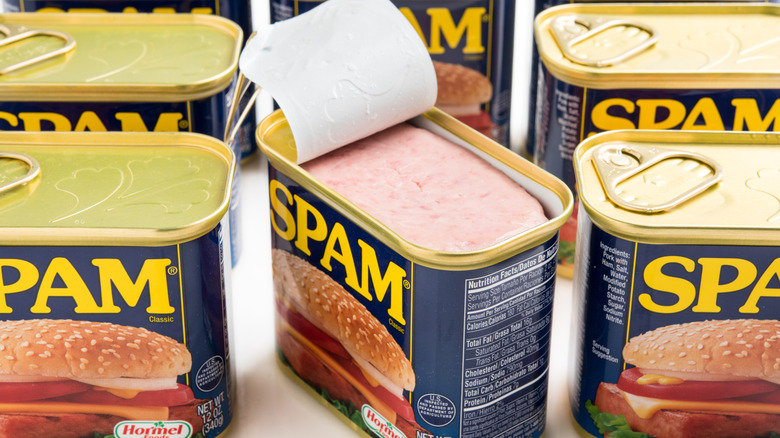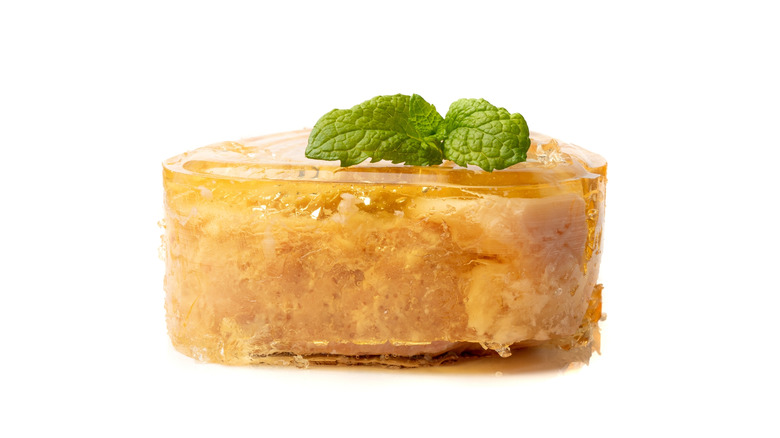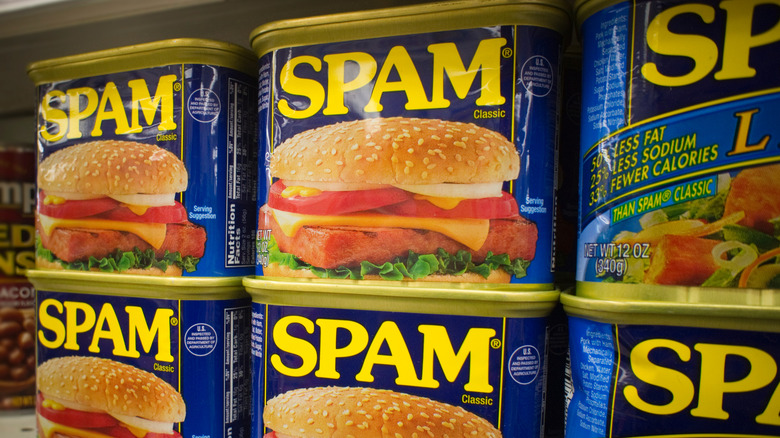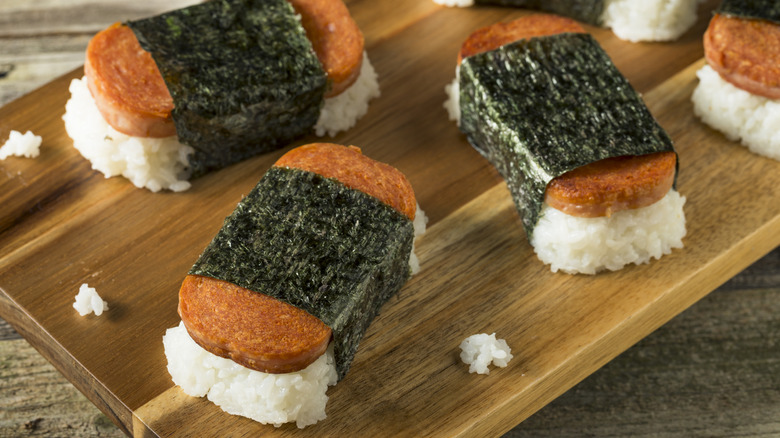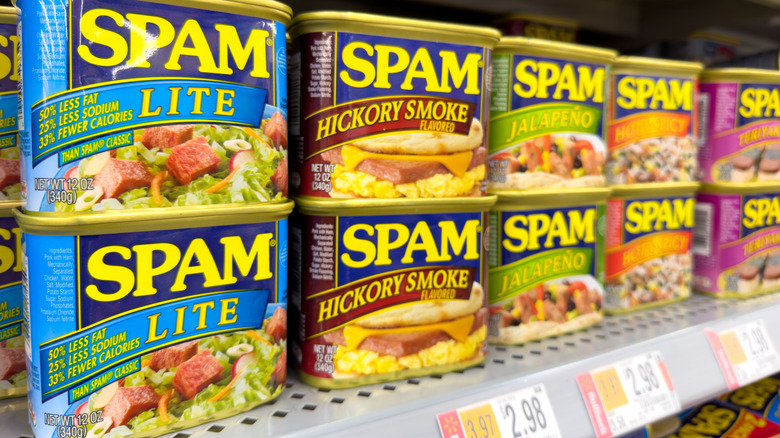Spam Myths We Really Need To Stop Believing
There are many adjectives to describe Spam. From savory and moreish to salty, processed, and rubbery, the pork product has certainly sparked discussion among food enthusiasts. Love it or hate it, there is little doubt that the pink luncheon meat has withstood the test of time. Launched in 1937 by the Hormel Foods Corporation as a way to utilize excess pork shoulder, which wasn't popular at the time, the product gradually gained a following after it was rationed to U.S. troops during World War II.
While it may be an acquired taste for some, there is no denying that Spam has its own unique culinary appeal. The canned meat is affordable and shelf-stable, which makes it a convenient pantry staple for those who like quick and easy meals. It's also ultra versatile, pairing well with a huge range of ingredients. Whether eaten on its own, served over rice and eggs, or fried until crispy, Spam has been embraced by home chefs around the globe.
Despite its popularity and long history, Spam remains widely misunderstood. Ready to find out more about this iconic pork product? Take a look at our roundup of common Spam myths we really should stop believing.
Spam is made with mystery meat
Since Spam meat isn't visually identifiable, there is no shortage of horror stories about the canned product. According to urban legends, the tinned protein contains everything from leftover meat scraps to unidentifiable parts of animals. The real story is much less sinister — and frankly, much less interesting. Spam contains just six ingredients — all of which are listed on the product's label. These include a blend of pork and ham, potato starch as a binder, salt, sugar, water, and sodium nitrite. While the final ingredient on the list may sound menacing, it's a preservative commonly used in processed meat.
Just like its ingredients, the Spam-making process is very simple. First, the pork and ham are ground together and combined with the other ingredients. The mixture is then placed in cans, which are vacuum-sealed and cooked. Once they cool, the tins are branded with labels before being distributed to grocery stores.
Spam has no nutritional value
Being a processed meat, Spam isn't exactly breaking new ground in the health and wellness department. Nevertheless, the canned product shouldn't be equated with junk food either. Spam contains a range of vitamins and minerals — this shouldn't be surprising, since it's mostly made of pork. Some of the product's nutrients include choline, thiamin, Vitamin B, zinc, selenium, and phosphorus.
The news is not all good, however. For this reason, it's best to eat Spam sparingly. In other words, it's not a product you should be consuming every day if you want to remain healthy. One 2-ounce serving of Spam (for context, one can of Spam contains 7 ounces) comes with 16 grams of fat, 40 milligrams of cholesterol, and 770 milligrams of sodium, which accounts for a whopping 33% of the recommended daily intake. Spam also contains sodium nitrite, which has been linked to an increased risk of cancer and diabetes.
The jelly that surrounds Spam inside the can isn't safe to eat
Just like many other canned meats, including corned beef, Spam is normally covered in a layer of gelatinous juices or a type of aspic. While it may not look particularly appealing, this jelly is perfectly safe to eat along with the pork, so you don't need to worry about separating it from the meat. The gelatinous substance is completely natural, since it forms during the meat's canning and cooking process. It is typically composed of the collagen from the skin, cartilage and tendons in the meat.
Dry gelatin is sometimes added to canned products, where it combines with the natural meat juices released during processing. This, in turn, forms a jelly that surrounds the product inside the can, cushioning it during shipment. The addition of dry gelatin to canned meat has to be disclosed on the label. Since Spam doesn't list gelatin as one of the ingredients, we can assume that the jelly inside the can is made solely from natural juices.
Spam never expires
Those who believe that some miraculous power prevents Spam from ever going bad are deeply misinformed. Just like all other pantry staples, Spam isn't going to remain at peak quality forever. Each can of Spam comes with a "best by" date, which indicates how long it will maintain its optimal flavor and texture. While you should never eat a product after it passes its "use by" date, the rules surrounding "best by" dates aren't as well-defined. Chances are that you will get away with eating a can of Spam that's past its "best by" date, although it may not be the most pleasant culinary experience.
Once the can of Spam is popped open, the race against time truly begins. While it may be tempting to leave Spam in the refrigerator and forget about it until you get hungry, the USDA recommends that canned meat should be eaten within three to four days of opening. During storage, Spam can be kept in the original tin, however, it's best to transfer it to a plastic or glass container to ensure that it retains flavor. Whatever storage option you choose, make sure that the Spam is completely wrapped or sealed to prevent it from drying out.
Spam was invented during World War II as army rations
While Spam became popular during World War II, the processed pork product was actually invented earlier. In 1937, Hormel Foods Corporation in Austin, Minnesota, launched Spam as an affordable and shelf-stable alternative to fresh meat. The product was developed as a way of making use of leftover pork shoulder, a product that wasn't all that popular at the time. Despite being advertised to housewives as a convenient meal solution, Spam didn't immediately take off because it didn't require refrigeration, which probably led home chefs to question its freshness.
The fact that it didn't require refrigeration was precisely what made Spam such an appealing food solution during World War II. More than 100 millions cans of the tinned meat were distributed to soldiers stationed in the Pacific. This is also one of the reasons why Spam took off in countries like Guam, the Philippines and Hawaii. Interestingly, the soldiers ate so much Spam that the flattened cans were sometimes repurposed into military cookware and even used to seal holes on the wings and fuselage of airplane bombers. Following its widespread use during the war, the sales of Spam increased dramatically, with Hormel rolling out its billionth can of the pink meat in 1959.
Everybody knows what Spam stands for
Although the meaning of the word "Spam" has been debated, there are a few theories about what the term stands for. According to the most popular account — mentioned at the Spam museum in Austin — the product name was made up by the brother of a Hormel executive, Ken Digneau, after the company held a naming contest. Apparently, Digneau won $100 for his efforts, which must have been a lot of money at the time.
The word "Spam" is said to be a portmanteau of "Spiced Ham," although some have debated this since there is nothing spicy about the popular pork product. Others, however, have claimed that the word must be an acronym of "Shoulder of Pork and Ham." Meanwhile, some other more humorous theories behind the name suggest that it's an acronym of "Stuff Posing as Meat" and "Scientifically Processed Animal Matter." At the end of the day, we will likely never know the full story behind the name of this popular tinned protein. As highlighted on the Spam website, "the real answer is known by only a small circle of former Hormel Foods executives. And probably Nostradamus."
The only way to eat Spam is straight out of the can
Just like canned ham, Spam doesn't need to be cooked before consumption. Instead, it's often eaten right out of the can, making it a perfect on-the-go snack or a handy camping staple. At its simplest, Spam can be sliced, diced, or even mashed and spread on bread or crackers for a quick snack. Nevertheless, the simplicity of this luncheon meat shouldn't stop you from exploring more creative ways to enjoy it.
Just like other sources of protein, Spam is ultra versatile. If you have an air fryer at home, you can easily use Spam to make air fryer Spam fries. Simply slice the canned meat into sticks and cook them in an air fryer at 400 F for 10 minutes. Alternatively, you can also make the snack in a regular skillet. If you are in the mood for real junk food, try your hand at a Spam and Dorito pie or a Spam and Dorito pizza, both of which combine the rich taste of Spam with the crispy texture of Doritos. Finally, why not use Spam as a handy alternative to traditional marinated pork in Spam tacos? While you'll need quite a few ingredients, the preparation process is relatively simple, making this Mexican-style feast a no-brainer.
Most Spam is produced in Hawaii
Hawaiians are huge fans of Spam. In fact, the residents of the archipelago consume 7 million cans of the pork product annually. In addition, each year, the Waikiki Spam Jam festival celebrates the state's love for this popular canned meat with a range of activities and Spam-inspired dishes. With so much enthusiasm for Spam, it's not surprising that many believe that Hawaii is a major producer of the product. However, this actually isn't the case.
Spam's popularity in Hawaii dates back to World War II when the U.S. shipped large quantities of the product to the archipelago as a sustenance for soldiers. While many of the GIs left, Spam stayed, becoming popular among the locals. Hawaii-born Syndi Halualani-Texeira comments on this in an interview with USA Today, saying, "Spam has been a staple in my family since I was a kid. I grew up eating Spam. My grandmother would cook it a million different ways. [...] It was inexpensive and could feed our large family. We thought Spam was the best thing next to rice."
One of the most popular Hawaiian Spam dishes is Spam musubi. The sushi-inspired snack consists of slices of fried or grilled spam and blocks of rice, held together with a strip of nori or seaweed. Readily available and affordable, the bite-sized treat is said to have been invented by Barbara Funamura, a Japanese-American woman, during World War II. Another popular Spam-based creation is Hawaiian Spam sliders, which combine the canned meat with mayo, garlic salt, onion powder, and Korean chili paste.
Spam is only popular in the U.S.
While there is little doubt that Americans consume a lot of Spam, the U.S. is by no means the only country where the tinned meat is a hit. In fact, Spam is sold in around 50 different countries, with 12.8 tins of the product eaten around the world every single second. Spam made its way across the world with American GIs during World War II.
In the U.K., the canned meat is often turned into spam fritters, battered and deep fried spam slices often served alongside mushy peas and chips. Spam is also very popular in Asia, where it was also introduced by American soldiers. In South Korea, spam is used to make budae jigae, which translates to "army base stew." The spicy dish combines the processed meat with ingredients like noodles, vegetables, and even slices of American cheese. Meanwhile, in the Philippines, Spam is frequently turned into spamsilog, a breakfast dish that consists of fried rice topped by a sunny-side up egg.
There is no connection between canned Spam and spam junk mail
Whether it's a phishing scam or a work-from-home job offer that sounds too good to be true, unsolicited emails don't just waste time but also present a very real security risk. While this may come as a surprise to many, there is a very clear connection between Spam, the iconic canned food, and spam, the flood of mass-targeted junk mail.
The origins of the word "spam," as it's used to describe unwanted emails, can be traced back to a British television series, "Monty Python's Flying Circus." In one of the episodes, a group of Vikings in a diner chant "Spam, Spam, Spam" after a server lists menu items, almost all of which contain Spam. The loud mantra drowns out everybody else at the establishment, making normal conversation impossible. Taking inspiration from the television series, in the 1990s, the word "spam" started being used in online chat rooms to disrupt repetitive or irrelevant comments. As the internet evolved, the term began being associated with the growing flood of unsolicited emails.
Predictably, Hormel wasn't happy with the name of its product being used in such a derogatory way. In 2002, the company unsuccessfully sued Spam Arrest, Spam Buster, and Spam Cube for trademark infringement. Hormel even took legal action against Jim Henson Productions over "Spa'am," a warthog character in "Muppet Treasure Island." The company's efforts to limit the use of the word "spam" were in vain, with the term added to the Oxford English Dictionary as both a pork product and unwanted messages in 2001.
Spam is always a low-class food
Spam became popular during World War II as a low-budget, long-life source of protein. Although it's been close to a century since Spam made its debut, many still look down on the luncheon meat as having very little culinary value. It hasn't helped that Spam is often used as an ingredient in fast meals that aren't exactly known for their high quality.
Despite its negative reputation among food purists, Spam isn't always about convenience and lowbrow meals. A number of restaurants in the U.S. are defying convention by incorporating the ingredient into their gourmet creations. One of them is San Francisco's Liholiho Yacht Club, which serves fried rice with kimchi, mushrooms, cured egg yolk, and housemade Spam. Meanwhile, Noreetuh in New York City offers a range of Hawaiian masubi, where Spam can be combined with a range of other ingredients, including Ossetra caviar. Another restaurant that proudly uses Spam in its kitchen is BUL Korean Bar & Restaurant in Washington D.C. More specifically, BUL's budae jjigae incorporates Spam, sausage, tofu, and kimchi.
Spam is only available in one flavor
While most of us are probably familiar with the original Spam, which consists of pork and ham, potato starch, salt, sugar, water, and sodium nitrite, it's not the only type of this pork product. Over the years, Hormel has expanded its Spam lineup to include a range of flavors. Spam also comes in "health-conscious" options, including Spam 25% Less Sodium and Spam Lite with 50% less fat, 25% less sodium, and 33% fewer calories.
Aside from its classic version, Spam is available in around 10 different flavors, catering to a range of tastes and culinary endeavors. Some of the specialty versions of the product include Spam Bacon, Spam Oven Roasted Turkey, and Spam Hickory Smoke Flavored. Regional Spam flavors include Spam Gochujang Flavored with fermented Korean spicy red chili paste and Spam Korean BBQ Flavor with garlic, ginger, soy sauce, paprika, sesame, and gochujang paste. There is also Spam Tocino inspired by the sweet cured pork popular in the Philippines. For those who enjoy experimenting with their luncheon meat, other Spam flavors include Spam Maple Flavored, Spam Hot & Spicy, and Spam Jalapeño.
Perhaps the most unusual Spam flavor to hit the supermarket shelves has been Figgy Pudding Spam. Launched in 2022 for a limited time, the product mimicked the flavors of a Christmas figgy pudding, a rich and spiced holiday dessert traditionally made with fruit. Figgy Pudding Spam featured similar flavors by combining pork with cloves, nutmeg, cinnamon, allspice, as well as fig and orange flavors.
